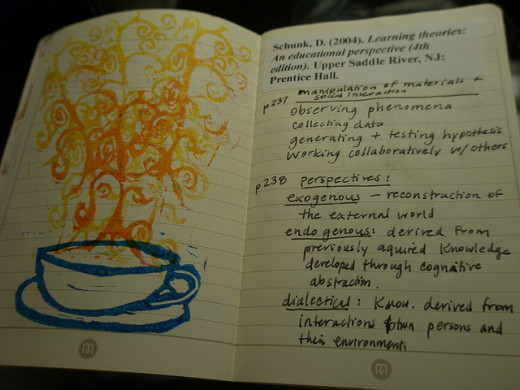Theory of Educational Practice

My theory of practice revolves around the idea that students and teachers alike are individuals that learn in different ways, and need to be recognized for their thoughts and ideas in relation to the improvement of the organization and the education of all. I am a strong believer in many of the theories discussed in the Owens text but am confused on which perspective you would like me to focus my answer, whether it be adults in an organization or students in the classroom.
“Many schools tend to evoke behavior that is conventional, conforming, submissive and controlled . . . the norms of such schools discourage behavior that questions the established order and proposes changes that challenge the conventional ways of the past” (Owens & Valesky, 2011, pg.4). I strongly believe in Social Psychology as a rule in developing desired behavior in students and teachers. Social Psychology supports the theory that behavior is shaped by two interacting forces, being an individual’s personality and the environment.
"Because the organization has no independent physical reality but exists only as a socially constructed reality, and because our construction of reality is dependent on our perception of what is real, we can easily see how the organization emerges as a primary factor in evoking the behavior of the people in it" (Owens & Valesky, 2011, pg.11).
This is the basis to me for why all of the other theories are so important. When you view everything else through the lens of knowing that all your actions and especially the environment you create for others is going to have such a critical impact on the behaviors of those therein, they have so much more meaning.
This is most certainly the first of the three intellectual pillars: Understanding the behaviors (motivations, decision making and conflict) of those in the organization. The next few theories will have an impact on this pillar as well.
There is no way to put these in an order signifying importance. I can only share them with you as a whole. Due to the environment’s importance in shaping the behaviors of those within, it’s significant to take into account each person’s individual personality, needs, and opinions. Rather it’s important to give them the respect they deserve as individuals. I therefore take a non-bureaucratic stance in developing organizations.
I believe that learning organizations are “not only adaptable to new challenges emerging in the world but are also adaptable to the worldwide rise in expectations for increased democracy, personal freedom, individual respect and dignity, and opportunities for self-fulfillment” (Owens & Valesky, 2011, pg.15).

Creating a positive environment with an organization does not take strict, dumbed-down rules and expectations, always looking over everyone’s shoulder to make sure that they are doing what is expected. Children and adults alike know when they are not trusted or respected. They know when expectations have been lowered so they can meet them.
What they need to know is that they can be given responsibilities and higher expectations and can be trusted to meet them. When they know where the company is heading, know that you need them to get there and they can stand behind the values of the organization, they are going to be more motivated to work harder for you. “Personal identification with and commitment to the values of the organization’s culture can provide powerful motivation for dependable performance even under conditions of great uncertainty and stress” (pg. 17).
This moves us deeper into the second of the three intellectual pillars: Understanding the organizational context in which people work. When organizations focus on the individuals within and on creating a positive, motivating organizational culture, they tend to be “associated with more active learning, cooperative planning by teachers and students, a greater recognition of individual differences, attempts to relate learning to ‘real life,’ and efforts to broaden the [organization’s] mission to address health, vocational, social, and community issues” (pg.38).
This progressive view of education focuses more on the students and teachers as individuals rather than on the retention of the information itself. When one focuses on people as individuals deserving respect and a voice within the organization, the needs of those people are better met and you have a more positive culture. This is where the theories of Piaget, Bruner and even Gardner come into the picture with Gardner’s Multiple Intelligences Theory.
Quick Poll
What interested you in this article?
"As Gardner has shown, though ones’ intelligences develop over time as one matures physiologically, their development also depends to a great extent on learning from the environment. Thus, one does not learn to read, write and calculate simply because one has matured (and is, therefore, presumably ‘ready’ to learn), but also because, for example, one has seen others read, write and calculate" (Owens & Valesky, 2011, pg. 50).
Gardner’s Multiple Intelligences Theory is based on the idea that people are not just intelligent because they are proficient in the linguistic or logical-mathematical areas, but that intelligence can be expressed in many different ways. I love the fact that he ties all of this back to the effect of the environment on one’s behaviors. By providing a solid example of desired behaviors in one’s own actions, an organizational culture can be created that is positive, encouraging, and motivating to others. Finally we have moved into the third of the three intellectual pillars: Leader behavior.
“It is your theory of practice that informs your method of school leadership; guides you in deciding what to do and what not to do when choices are difficult and urgent; and renders your behavior as a leader understandable, believable, and therefore trustworthy to others” (Owens & Valesky, 2011, pg.59).
I believe that if you can provide a positive example as a leader in an uplifting positive environment, treating everyone with respect and dignity, all the while holding yourself to the same standards as you hold all others and showing others that they are valued and their opinions and needs matter, you will have just the right ingredients for an effective organization.

References
Owens, R. & Valesky, T. (2011). Organization behavior in education: Leadership and school reform (Tenth edition). Upper Saddle River, NJ: Pearson Education Inc.
Quick Poll
What did you think of this article? Was it helpful to you?
© 2013 Victoria Van Ness







